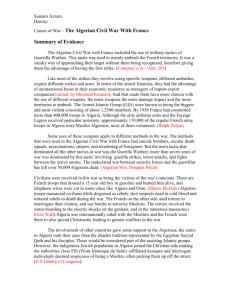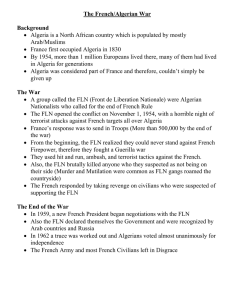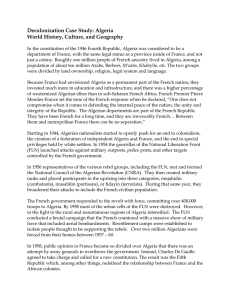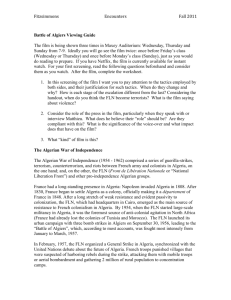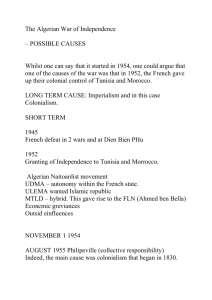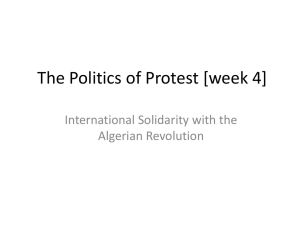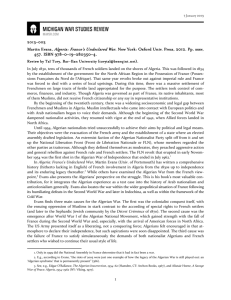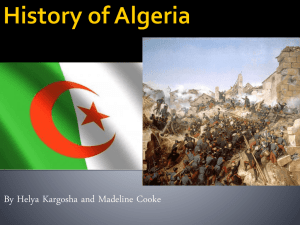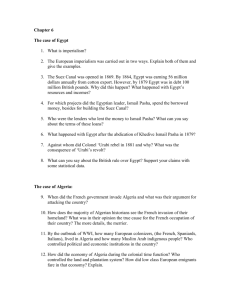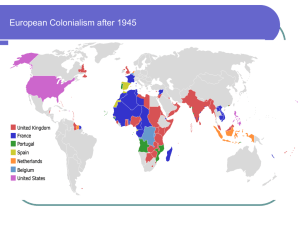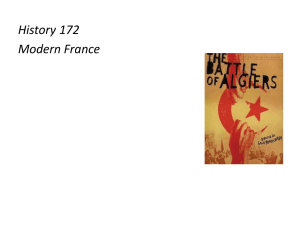The Algerian War
advertisement
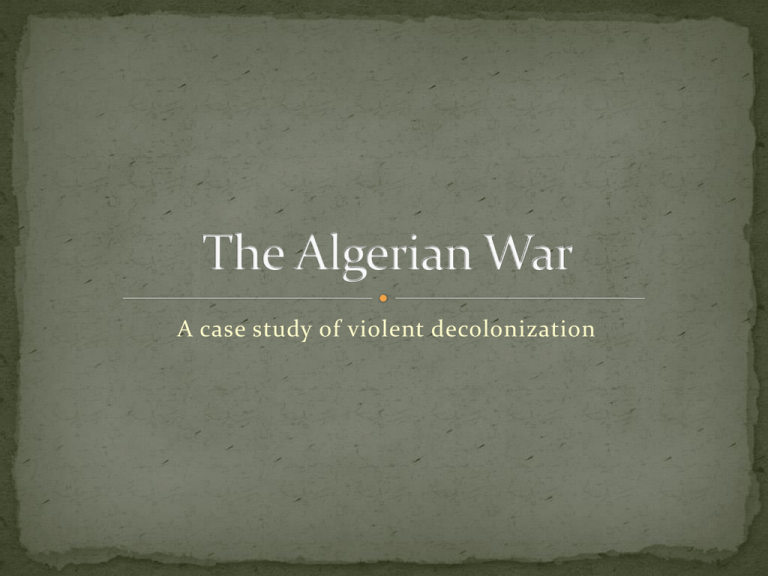
A case study of violent decolonization 1954-1962 War between Algeria and France resulting in Algerian independence Extremely violent: perhaps 300,000 killed Terrorism, guerilla warfare, torture, and atrocities on both sides Case study of independence through violence 1830: France invades Algeria 1848: Algeria becomes a departement of France French settlers (piedsnoirs or colons) migrate in large numbers Land French government distributed prime land to pieds- noirs Economic inequality Power French citizens had more rights than Algerian Muslims Settlers blocked moves to give Muslims more rights Worldwide trend of decolonization, 1945-1960s Founded November 1, 1954 Coalition of Algerian nationalist groups Became the major combatant against the French in the Algerian War May 8, 1945: V-E Day Activists demonstrated for Algerian independence Fight between protesters and French police Muslim protestors killed 103 Europeans that evening French military cracked down and took revenge, killing thousands March 13 – May 7, 1954 Battle in Vietnam resulting in defeat of French army by Vietnamese nationalists Resulted in French withdrawal from Vietnam Sign of French military weakness November 1, 1954: FLN launched coordinated attacks across Algeria, killing 7 people FLN declared goal of establishing an independent Algeria Sparked a series of attacks and counter-attacks by French and Algerian forces Irregular combatants Surprise attacks High mobility Sabotage Avoidance of direct confrontation Often used by weaker forces against more conventionally powerful opponents August 1955 FLN massacred 123 people in Philippeville, including civilians – a change in tactics French army responded with massive retaliation, killing thousands Terrorism succeeded – generated tremendous support for the FLN “European mothers were found with their throats slit and their bellies dashed open… infants in arms had their brains dashed against the wall.” “There were so many [dead Muslims] that they had to be buried with bulldozers.” September 30, 1956: women bombed three sites in Algiers, the capital Started a year-long guerilla campaign in Algiers Civilian casualties; heavyhanded response Bombings spread a sense of insecurity – war was everywhere FLN aimed to draw more attention by attacking cities French Algerian Torture Torture Illegal executions Terrorism Military rule – no Targeting civilians – democracy Forced disappearances Censorship especially Muslims Algeria and other crises undermined faith in the French government May 1958: angry piedsnoirs demanded the return of Charles de Gaulle to keep Algeria French De Gaulle took over France on June 2, 1958 Expense Domestic opposition International opposition September 1959: de Gaulle offered Algeria a vote on its future status after violence stopped Possibility of independence angered pieds-noirs, led to unrest Fall 1961: France began secret negotiations with FLN March 1962: ceasefire signed April 1962: 90% of French voters endorsed Algerian independence July 1, 1962: Algerians voted for independence, 6 million versus 17,000 July 3, 1962: Algeria became an independent state Signed March 18, 1962 Provisions: Ceasefire France recognizes Algeria’s right to independence and agrees to withdraw troops Algeria guarantees political and economic rights to pieds-noirs Violently opposed by some radical settlers Approved by French and Algerian voters by July 1962 Nearly 1 million Europeans left Algeria before independence Organization de l’Armee Secrete (OAS) Founded December 3, 1960 Radical French settlers dedicated to keeping Algeria French Attempted to stop the progress of Algerian independence Assassination attempts against de Gaulle and Sartre Reprisals against supporters of France Algerian Muslims who fought for or supported the French Significant contribution to the French war effort – roughly 236,000 by 1962 Many fled to France after the end of the war Between 50,000 and 150,000 Harkis and families killed after independence
